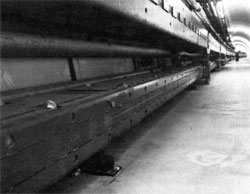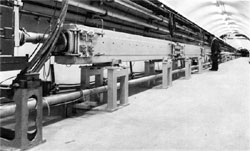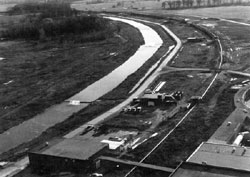Well Done!
...was the accolade with which Accelerator Division Head Rich Orr and Deputy Head Helen Edwards greeted the troops emerging from the Main Ring tunnel as the six-month shutdown of the accelerator came to an end. Some of the "tunnel rats" had not seen daylight for weeks, coming in early and leaving late with the entire day spent in the tunnel.
There was much to show for their efforts. Linac Group Head Cy Curtis could point to a new, sophisticated microprocessor-based control system designed by the group led by Mike Shea.
Booster Group Head Curt Owen had stolen a march on the main accelerator by doing early testing of improvements in the Booster systems and was gratified to see a new record of 4.3xl013 protons from the Booster in the equivalent of one Main Ring cycle. Improvements in the 8-GeV line from the Booster to the Main Ring should enhance the transmission between the two machines leading to improved performance of the Main Ring.
In the Main Ring, primary emphasis was on the installation of Energy Saver components under the direction of Accelerator Systems Group Head Peter Limon, ably supported by groups under Larry Sauer and Max Palmer. By the end of the shutdown they could "point with pride" to having the Al, A2, and A3 cry loops installed, vacuum tight, and ready for cooldown. Coupled with the work of the Controls Group under Dixon Bogert, the two Refrigeration Groups under Claus Rode and Dick Andrews, the Central Helium Liquefier Group under Ron Walker, and the Power Supply Group under Gerry Tool, this installation is the final major test of the Energy Saver. It involves 118 superconducting magnets, three satellite refrigerators and the Central Helium Liquefier, the 5000 amp power supply, and the full control system.
While all this was going on in A-sector, preparatory work was being carried out in the rest of the ring. At the E0 straight section Mike Harrison and the Conventional Devices Group under George Biallas installed the complicated system of magnets and kickers needed to inject the beam into the Saver from the Main Ring. The compressor stations at E0 and F0, with four helium compressors each, were commissioned under Dick Andrews. Ed Kessler of the Electrical Support Group directed the installation of hundreds of miles of cable around the ring. With the accelerator turned off, the Operations Group under Bob Mau turned to Saver installation. Bill Merz oversaw installation of many miles of copper control tubing needed for the full Saver. Duane Plant and Debra Baddorf saw to terminating the cabling for A, E, and F-sectors, involving 10,000 connections per sector.
By the end of the shutdown, besides having the Main Ring ready for 400-GeV operation, the Accelerator Division, with generous assistance from many elements of the Research Division and various Laboratory support groups had 3 (of 24 total) cryoloops of the Saver ready for operation; 15,000 out of 22,000 feet of transfer and high pressure helium lines were completed on top of the berm, thanks to Don Richied and the Paramount Park crew and the leak-checking crews under Mark Leininger; all of the 24 refrigeration buildings and Service Building Controls enclosures were complete; 18,000 of 22,000 feet of helium and nitrogen collection piping were installed in the tunnel; all of the cable trays and pneumatic tubing for the entire project were in place; the cabling for half of the Ring was complete; in addition to the A-sector magnet installation, 90 additional dipoles selected by Don Edwards and Leo Michelotti were installed in the El, E2, and F4 cryoloops.
Back on the assembly front, Dick Lundy's people in Industrial Buildings 1 and 3 had reached an assembly rate of 12 dipoles per week; the Magnet Test Facility under Frank Turkot achieved a rate of 14 magnets/week; and at Lab 5 Del Miller's crew completed cryostat assembly and turned their attention to spool pieces, while the crew at Lab 2 under Al McInturff set up a spool-piece measuring facility.
Not to be outdone, Quentin Kerns' RF Group completed the first of the three radiofrequency cavities for the Saver.






